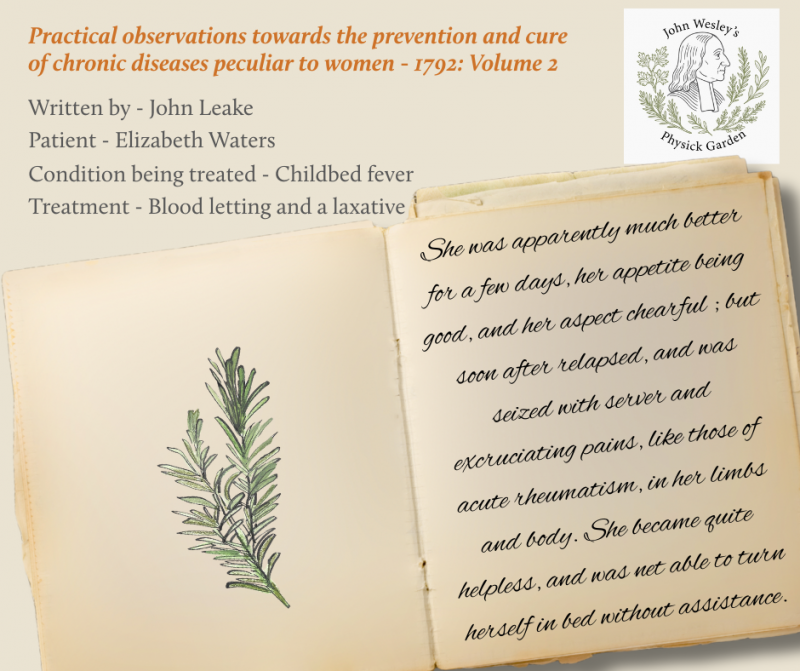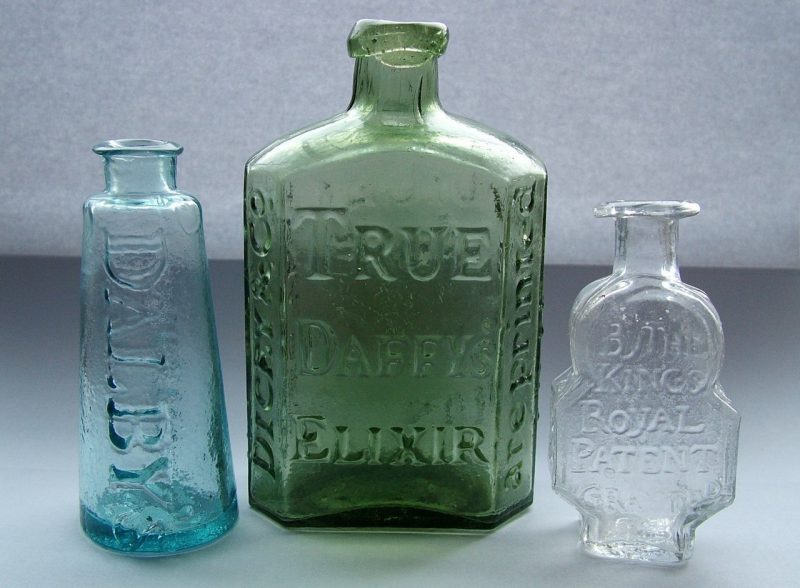The numbers listed under each plant are the number of the remedy as it appears in the 4th edition – reprinted in London in 1847 of Primitive Physick.
Honeysuckle / Woodbine (Lonicera caprifolium)
Honeysuckle has many names including woodbine, beerbind, evening pride, and fairy trumpets. It is also one of the plants thought to avert the evil powers abroad on May Day. It was considered to take care of cows, butter and milk, especially in the Scottish Highlands. Traditionally it was thought that if honeysuckle was brought into a house a wedding would follow. If the flowers were placed in a girl’s bedroom she was sure to have dreams of love. Shakespeare refers to honeysuckle as woodbine in “A Midsummer Night’s Dream”. The plant appears in John Gerard’s sixteenth century herbal, where he wrote that “the flowers soaked in oil and set in the sun are good to anoint the body”.
Wesley’s recommendations
105 – A fever – Stamp a handful of leaves of woodbine, put fair water into it and use it as a cold clyster. It often cures in an hour
213 – Venomous sting – Apply juice of honeysuckle leaves
Other therapies
Honeysuckle is used in Bach flower remedies for homesickness, regrets or grief and bereavement.
Soloman’s Seal (Polyganum multiflorum)
Solomon’s Seal, also called David’s Harp and Ladder-to-Heaven, has traditionally been used in Chinese medicine. The name comes from the Greek, polys meaning many, and gonu meaning knee joint, referring to the jointed rhizomes. The name multiflorum means ‘many-flowered’. The red or black berries however, are HARMFUL if eaten and TOXIC to pets (dogs) – you should wear gloves and and other protective equipment when handling.
Wesley’s recommendations
190 – A rupture – Take agrimony, spleenwort, Solomon’s Seal, strawberry roots, a handful of each, pick and wash them well, stamp and boil them, two hours in two quarts of white wine in a vessel close stopped. Strain and drink a large glass of this every morning and an hour after drink another. It commonly cures in a fortnight. A good truss in the meantime is of great use, and perhaps the only thing to be depended on.
Other therapies
The traditional use of Polygonatum in the treatment of diabetes was first observed in 1930 by Hedwig Langecker. After experiments, she concluded that it was effective in fighting nutritional hyperglycemia. It is also believed to be restorative to mental vitality, especially when the mind has been overworked, overstressed, or is in a state of exhaustion.

Agrimony (Agrimonia eupatoria)
Common alternative names include Aaron’s rod, liverwort, cockleburr, church steeples, money in both pockets, and sticklewort. Argimonia comes from the Greek word argemone which means cataracts, The Greeks believed the plant had special powers in treating eye complaints. It was mentioned in the Anglo-Saxon “salve” as a medicinal herb. It was thought to be useful curing warts and treating snake bites and wounds.
Wesley’s recommendations
190 – A Rupture
190 – A rupture recipe
195 – Inflammation or swelling of the scrotum.
262 – Ulcer in the bladder or kidneys – Take decoction of agrimony thrice a-day
270 – Bloody urine – Take twice a day a decoction of agrimony
286 – Putrid wounds – Wash them morning and evening with a warm decoction of agrimony. If they heal too soon, and a matter gathers underneath, apply a poultice of the leaves pounded changing them once a day-till well.
Other therapies
In Germany today, Agrimony is used to treat gallstones and cirrhosis of the liver, in China it is a treatment for excessive bleeding and in France it is a cure for bed-wetting. In the 16th century the herbalist John Gerard held that “a decoction of the leaves is good for them that have naughty livers”. Due to its astringent properties that help treat so many conditions, this can also exacerbate constipation, so use with caution.
To prevent catching any infectious fever, do not breathe near the face of the sick person, neither swallow your spittle while in the room – JOHN WESLEY
Wood Sorrel (Oxalis acetosella)
Wood sorrel has long been associated with St. Patrick, who is alleged to have used the plant’s trifoliate leaves to illustrate the Holy Trinity. Wood sorrel is sometimes called a shamrock as a result, though the true shamrock title is commonly attributed to clovers instead.
Wesley’s recommendations
105 – A Fever – use pippin or wood-sorrel tea; or pippin whey or wood-sorrel whey
Other therapies
The tangy, lemony taste of wood sorrel leaves can make them a tasty addition to salads or soups. They can also be used to make tea, drunk in the past as a treatment for ailments such as indigestion or fever. Caution should be taken though, as the oxalic acid that gives the leaves its characteristic taste can be TOXIC if consumed in large quantities.
Spleenwort (Asplenium trichomanes)
Spleenwort is also called Hart’s tongue by some. According the Primitive Physick – Take Agrimony, Apleenwort, Solomon’s Seal, Strawberry-roots, a handful each, pick and wash them well, stamp and boil them two hours, in two quarts of white wine in a vessel close stopt, Strain and drink a large glass of this every morning, and an hour after drinking another. It commonly cures in a fortnight. (551) Maidenhair Spleenwort is also a popular plant in folklore and legends. In some European legends, the fern is said to bloom only once a year, on the night of St. John, and those who can find the flowering fern are granted good fortune and prosperity.
Wesley’s recommendations
190 – A rupture recipe
Other therapies
It is said to be binding and strengthening, and especially a cleanser of the spleen, stones in the bladder, yellow jaundice, and hiccupping. In Western herbal medicine, green spleenwort has been used as a treatment for liver and spleen disorders, as well as for rheumatism and arthritis.
Elecampane (Inula helenium)
This herb originated in central Asia and is in the sunflower family. There are various stories about its Latin name, but it is more commonly known as horse-heal and elfdock. One story says it was being picked by Helen of Troy when she was carried off by Paris. A more ordinary explanation is that it grew well on the island of St. Helena. It was known to the Greeks and Romans, who ate it boiled. It has a reputation for promoting good digestion as well as mirth. In the 17th century it was believed to cure the plague and other fevers, as well as being an antidote to the venom of serpents. It has been used to flavour liquors such as Absinthe. The Pilgrim Fathers took it to America where it was widely used to cure skin complaints and to doctor sheep and horses.
Wesley’s recommendations
39 – The cholic – Take as much Daffy’s elixir as will presently purge. This relives the most violent cholic in an hour or two
Other therapies
Elecampane contains sesquiterpene lactones, a class of phytochemicals that have been studied in recent years due to their anti-inflammatory activity. It is also used in cough syrups as this herb works to expel phlegm from the lungs. Elecampane has also been found to be one of the best herbs for sore throat pain, along with herbs such as horehound and liquorice.
Daffy’s Elixir was one of the most popular and frequently advertised patent medicines in Britain during the 18th century. It is reputed to have been invented by clergyman Thomas Daffy, rector of Redmile, Leicestershire, in 1647. He named it elixir salutis (lit. elixir of health) and promoted it as a generic cure-all. An early recipe for “True Daffy” from 1700 lists the following ingredients: aniseed, brandy, cochineal, elecampane, fennel seed, jalap, manna, parsley-seed, raisin, rhubarb, saffron, senna and Spanish liquorice. Chemical analysis has shown this recipe to be a laxative made mostly from alcohol.
Strawberry (wild) (Fragaria Vesca)
Alpine and Wild European strawberries are native to Europe, north of the Alps. Although there are mentions of wild strawberries they are not mentioned in cultivation until the 13th century. By the reign of Henry VIII the fruit was highly esteemed and cost four pence a bushel.
Wesley’s recommendations
190 – A rupture recipe
Other therapies
The root is used extensively for a range of disorders as it is astringent, diuretic and a tonic. It is used to treat diarrhoea, bowel infections, disorders of the metabolism and bladder stones.
Such a delirium (a high fever) is often cured by applying warm lambs liver to the head – JOHN WESLEY









